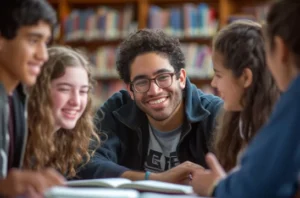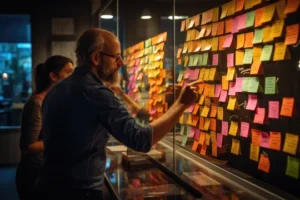In today’s dynamic world, collaboration is no longer a nicety; it’s a fundamental skill for success. Educational innovation is embracing this reality, with collaborative learning taking center stage. This approach harnesses the power of group dynamics to enhance learning, fostering not only a deeper understanding of concepts but also essential social skills. Dive into the essence of collaborative learning and explore practical strategies to ensure its successful implementation in your classroom.
Unveiling the Power of Collaborative Learning: 
Collaborative learning involves students working together in groups to solve problems, complete tasks, or delve into new concepts. It’s rooted in the powerful idea that learning is a social endeavor. By pooling their resources and diverse perspectives, students achieve a richer understanding and retain information more effectively. Here’s a closer look at the benefits of collaborative learning:
-
Enhanced Knowledge Retention: Through active participation in discussions and group problem-solving, students engage with the material on a deeper level, leading to stronger knowledge retention.
-
Development of Critical Thinking Skills: Collaborative learning encourages students to analyze information, evaluate different viewpoints, and arrive at well-reasoned conclusions, fostering critical thinking skills.
-
Communication and Teamwork Skills Flourish: Working together in groups hones vital communication skills like active listening, clear expression of ideas, and respectful negotiation. Students also learn the art of teamwork, understanding how to collaborate effectively toward common goals.
-
Boost in Confidence and Self-Esteem: Collaboration allows students to contribute their unique strengths, fostering a sense of belonging and empowering them to share their ideas with confidence. This can lead to increased self-esteem and a growth mindset.
Strategies for Flourishing Collaborative Learning: 
Now that we’ve explored the advantages of collaborative learning, let’s delve into practical strategies to ensure its success in your classroom:
-
Establish SMART Objectives: The foundation of successful collaboration lies in clearly defined goals. Set SMART objectives (Specific, Measurable, Achievable, Relevant, Time-bound) for each collaborative activity. These objectives should clearly outline the learning outcomes and the expected contributions of each student within the group.
-
Foster a Positive Group Environment: A supportive and inclusive environment is crucial for successful collaboration. Encourage respect, open communication, and active listening among group members. Establish ground rules at the outset that outline expectations for behavior and interaction. Utilize icebreaker activities or team-building exercises to help students feel comfortable working together.
-
Leverage Diverse Strengths: Recognize and harness the unique skills and knowledge each student brings to the table. Encourage students to identify their strengths and how they can contribute to the group’s success. This might involve assigning roles within the group that play to individual strengths (e.g., organizer, researcher, presenter).
-
Incorporate Technology Strategically: Technology can be a powerful tool to enhance collaboration. Utilize digital tools for communication (e.g., online discussion forums, messaging platforms), document sharing (e.g., collaborative document editors, cloud storage), and project management (e.g., project management software, online task boards). However, ensure the chosen technologies complement the learning objectives and don’t hinder collaboration.
-
Monitor and Guide Progress: While fostering student-centered learning, your involvement as an educator remains crucial. Regularly monitor group progress, offer constructive feedback, and address any challenges that may arise. You can do this through check-ins, providing resources, or facilitating discussions to ensure the collaboration stays on track and meets learning objectives.
-
Evaluate Group and Individual Performance: Assessment should reflect both collective achievements and individual contributions. Utilize a mix of self-assessment tools where students reflect on their participation, peer review exercises where students assess each other’s contributions, and instructor evaluation that provides feedback on both collaboration skills and understanding of the content.
-
Embrace Reflection: Reflection is a vital component of the learning process. After completing collaborative projects, encourage students to reflect on their experiences. This can be done through journal entries, class discussions, or exit tickets. Reflection allows students to analyze their learnings, identify areas for improvement in future collaborations, and celebrate their successes.
Conclusion: 
Collaborative learning transcends mere group work. It’s about creating a synergistic environment where collective wisdom leads to a deeper understanding and a stronger sense of community. By implementing these strategies, you can cultivate a classroom culture that values teamwork, shared responsibility, and the power of learning together. Your students will not only develop a solid academic foundation but also hone critical interpersonal skills essential for navigating the collaborative world they’ll encounter beyond the classroom.
Call to Action: 
We want to hear from you! Share your collaborative learning success stories or your favorite teamwork strategies in the comments below. Let’s inspire educational excellence together!







